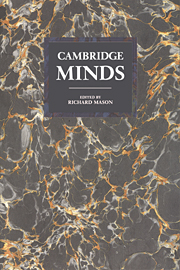Book contents
- Frontmatter
- Contents
- Notes on contributors
- Preface
- 1 The effects of a broken home: Bertrand Russell and Cambridge
- 2 I. A. Richards, F. R. Leavis and Cambridge English
- 3 Emily Davies, the Sidgwicks and the education of women in Cambridge
- 4 Radioastronomy in Cambridge
- 5 Three Cambridge prehistorians
- 6 John Maynard Keynes
- 7 Mathematics in Cambridge and beyond
- 8 James Stuart: engineering, philanthropy and radical politics
- 9 The Darwins in Cambridge
- 10 How the Burgess Shale came to Cambridge; and what happened
- 11 Ludwig Wittgenstein
- 12 ‘Brains in their fingertips’: physics at the Cavendish Laboratory 1880–1940
- 13 J. N. Figgis and the history of political thought in Cambridge
- 14 Molecular biology in Cambridge
- 15 James Frazer and Cambridge anthropology
- 16 Michael Oakeshott
12 - ‘Brains in their fingertips’: physics at the Cavendish Laboratory 1880–1940
Published online by Cambridge University Press: 21 October 2009
- Frontmatter
- Contents
- Notes on contributors
- Preface
- 1 The effects of a broken home: Bertrand Russell and Cambridge
- 2 I. A. Richards, F. R. Leavis and Cambridge English
- 3 Emily Davies, the Sidgwicks and the education of women in Cambridge
- 4 Radioastronomy in Cambridge
- 5 Three Cambridge prehistorians
- 6 John Maynard Keynes
- 7 Mathematics in Cambridge and beyond
- 8 James Stuart: engineering, philanthropy and radical politics
- 9 The Darwins in Cambridge
- 10 How the Burgess Shale came to Cambridge; and what happened
- 11 Ludwig Wittgenstein
- 12 ‘Brains in their fingertips’: physics at the Cavendish Laboratory 1880–1940
- 13 J. N. Figgis and the history of political thought in Cambridge
- 14 Molecular biology in Cambridge
- 15 James Frazer and Cambridge anthropology
- 16 Michael Oakeshott
Summary
The Cavendish Laboratory is probably one of the most famous scientific institutions in the world. The home of Cambridge University's Department of Physics, it attained in the late nineteenth century, and has retained throughout the twentieth, an international reputation for excellence in physics teaching and research. It has produced some of the most consequential and innovative scientific work of the last hundred years – including the disclosures of the electron (1897), the proton (1920) and the neutron (1932), the isotopes of the light elements (1919), the artificial splitting of the atom (1932), the elucidation of the structure of DNA (deoxyribonucleic acid) (1953) and the discovery of pulsars (1967). Since the foundation of the awards in 1901, over twenty Cavendish and Cavendish-trained physicists have won the Nobel Prize for Physics or Chemistry, among them J. J. Thomson in 1906, Ernest Rutherford in 1908, W. L. Bragg in 1915, F. W. Aston in 1922, James Chadwick in 1935, E. V. Appleton in 1947, P. M. S. Blackett in 1948, Crick and Watson in 1962, Hewish and Ryle in 1974, and Peter Kapitza in 1978. Indeed, such is the Laboratory's fame and prestige that it has sometimes been described as a ‘nursery of genius’. The Cavendish Laboratory occupies a special place in both the history of physics and in the lore of Cambridge science.
- Type
- Chapter
- Information
- Cambridge Minds , pp. 160 - 176Publisher: Cambridge University PressPrint publication year: 1994

